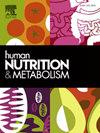Pantothenic acid plays an important role in reducing body weight
IF 1.8
Q3 ENDOCRINOLOGY & METABOLISM
引用次数: 0
Abstract
Background
Obesity is characterized by excessive fat accumulation. Strategies to effectively curb the prevalence of obesity have always garnered significant attention. If reducing fat can be achieved by altering the content of certain nutrients in the diet, it would not only be simple and convenient but also alleviate the economic burden.
Methods
Four-week-old ICR mice were divided into two groups: a Normal diet group and a High-fat diet group. The weight changes of the mice were observed. Feces from obese mice were collected, and blood cultures and MacConkey medium were used to observe and isolate bacterial changes. Bacteria were preliminarily identified using Gram staining, mass spectrometry, and biochemical culture. Differential bacteria were administered by gavage, and changes in mouse weight and abdominal fat were observed. Whole genome sequencing was employed to further identify the types of bacteria. The relationship between triglycerides and total cholesterol in the Body Mass Index of different genders was retrospectively analyzed. Feces were collected, and the number of Escherichia coli with different Body Mass Indices was detected using PCR. Metabolomics was utilized to identify differential metabolites in bacterial culture supernatants. The effects of pantothenic acid on the weight and abdominal fat of BALB/c mice of different genders on a normal diet and a high-fat diet were observed. Transcriptomics was used to identify differential genes in mouse liver and analyze their association with immune cells. Macrophages were eliminated to observe the effect of a high-fat diet on adipogenesis. The Lip-MC method was used to screen proteins in the liver that may bind to pantothenic acid, and these were cross-linked with the upregulated genes of RAW264.7 after pantothenic acid administration. The molecular docking method was used to analyze the binding of pantothenic acid and orlistat to the target protein.
Results
Obesity can lead to changes in the diversity of intestinal flora. Certain bacteria in the intestine can reduce fat formation, and the most likely candidate identified is Escherichia coli. The population of Escherichia coli in obese individuals significantly increases. Triglycerides and total cholesterol levels rise significantly when the Body Mass Index (BMI) is ≥ 24, with no gender difference observed. Escherichia coli can produce a significant amount of pantothenic acid, which can markedly decrease abdominal fat formation. Liver macrophages play a crucial role in abdominal fat formation. Pm20d1 in macrophages may interact with pantothenic acid to influence liver fat metabolism (see flow chart).
Conclusions
Consumption of pantothenic acid can lead to a substantial decrease in body weight among female mice that have been on a high-fat diet. Concurrently, it also notably lowers the body fat percentage in both male and female mice subjected to a high-fat diet, a process that might be associated with triglycerides. The role of liver macrophages is significant in this context.

泛酸在减轻体重方面起着重要作用
背景:肥胖的特征是过度的脂肪堆积。有效遏制肥胖流行的策略一直备受关注。如果通过改变饮食中某些营养素的含量来实现减脂,不仅简单方便,而且还能减轻经济负担。方法4周龄ICR小鼠分为正常饮食组和高脂饮食组。观察小鼠体重变化。收集肥胖小鼠粪便,采用血培养和MacConkey培养基观察分离细菌变化。采用革兰氏染色法、质谱法和生化培养法对细菌进行初步鉴定。通过灌胃给予差异菌,观察小鼠体重和腹部脂肪的变化。采用全基因组测序进一步鉴定细菌类型。回顾性分析不同性别人群体重指数中甘油三酯与总胆固醇的关系。收集粪便,采用PCR检测不同体质量指数的大肠杆菌数量。利用代谢组学方法鉴定细菌培养上清液中的差异代谢物。观察泛酸对不同性别BALB/c小鼠正常饮食和高脂饮食体重和腹部脂肪的影响。转录组学用于鉴定小鼠肝脏中的差异基因,并分析它们与免疫细胞的关系。清除巨噬细胞,观察高脂饮食对脂肪形成的影响。Lip-MC方法筛选肝脏中可能与泛酸结合的蛋白,这些蛋白与泛酸给药后RAW264.7上调的基因交联。采用分子对接法分析泛酸和奥利司他与靶蛋白的结合。结果肥胖可引起肠道菌群多样性的改变。肠道中的某些细菌可以减少脂肪的形成,最可能的候选者是大肠杆菌。肥胖个体的大肠杆菌数量显著增加。当身体质量指数(BMI)≥24时,甘油三酯和总胆固醇水平显著升高,无性别差异。大肠杆菌可以产生大量的泛酸,可以显著减少腹部脂肪的形成。肝巨噬细胞在腹部脂肪形成中起着至关重要的作用。巨噬细胞中的Pm20d1可能与泛酸相互作用,影响肝脏脂肪代谢(见流程图)。结论:在高脂肪饮食的雌性小鼠中,摄入泛酸可以导致体重大幅下降。同时,它还显著降低了高脂肪饮食的雄性和雌性老鼠的体脂百分比,这一过程可能与甘油三酯有关。在这种情况下,肝巨噬细胞的作用是显著的。
本文章由计算机程序翻译,如有差异,请以英文原文为准。
求助全文
约1分钟内获得全文
求助全文
来源期刊

Human Nutrition and Metabolism
Agricultural and Biological Sciences-Food Science
CiteScore
1.50
自引率
0.00%
发文量
30
审稿时长
188 days
 求助内容:
求助内容: 应助结果提醒方式:
应助结果提醒方式:


